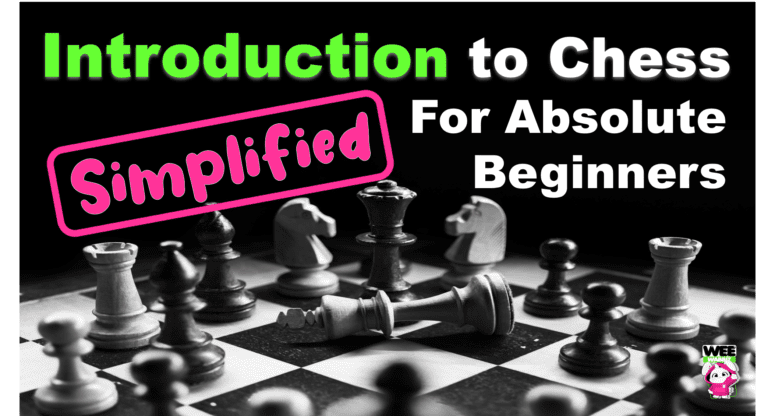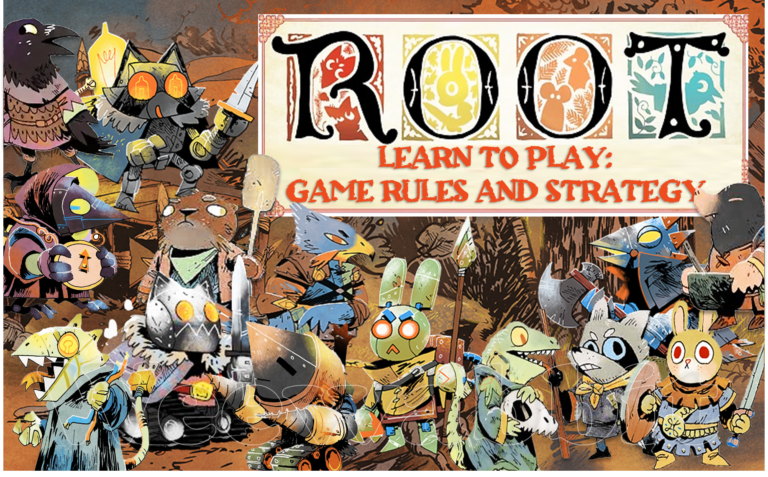Hi! Welcome to your next chess adventure! If you’ve mastered the basics from our “Beginner’s Guide“, you’re ready to tackle chess strategy. In this article we are gonna breaks down complex gameplay strategies into easy-to-understand baby steps. Like with our previous guide, we’ll have images and short video clips. WEE‘s here to help you think, plan, and play like a seasoned chess player. Ready to elevate your game? Let’s go!
Now, if you’re absolutely new to Chess, WEE suggest to start with the Basic first before going to Strategy. Here’s to start you with…
Otherwise let’s proceed
We’ll begin by dividing a chess game into three parts…
The Three Phases of a Chess Game
It’s important to know that every chess game is divided to three main phases, the opening, the middlegame, and the endgame. Each stage has its own strategies and goals.
Let’s start with the…
The Opening
Bringing the Army into Play
The Opening is the first phase of the game, it is where we set up our pieces for the battles to come and it’s all about preparation and positioning. The main goals are to control the center of the board, develop our pieces to active positions, and ensure our king’s safety. A good opening lays the foundation for a successful game.
Here’s a closer look at what we should aim to achieve during the Opening.

1. Control of the Center
The center of the board is incredibly valuable in chess. It’s the crossroads for our pieces, it lets our pieces move around the board more easily and have a bigger impact on the game. When we control the center, we can attack and defend more effectively.
By advancing our central pawns (typically the ones in front of the king and queen), we can exert influence over this key area early on.


2. Develop Your Pieces
“Develop your pieces” means “to move your pieces.” When we start a chess game, it’s like preparing for a big battle. To get ready, we need to move our pieces out where they can do the most good.
Try to move the..
Knights and Bishops
These pieces are great at the start because they can reach the middle of the board quickly.
If we move out our Knights toward the center squares ( like Nf3 or c3 for White ) ( Nf6 or Nc6 for Black ). This lets them control important areas.


For our Bishops, we should place them so they can move along long, clear paths that cover a lot of the board. ( like c4 or b5 for White ) ( Bc5 or Bb4 for Black )
Remember to…

Save the Big Guns for Later
It might be tempting to use the queen and rooks early because they’re very strong, but they work better later in the game. Early on, they can be easy targets for smaller pieces. Lets keep them safe until the board is more open and they can really make a big impact.
Also…
Move One Piece at a Time
A good rule in chess is to try and move each of the pieces once before moving any piece a second time. This helps us make sure all our pieces are doing something useful, and not just sitting back watching the action. This way, the whole team is working together right from the start.
Protect the King at all time…

3. Ensure King Safety by Castling
The king’s safety is an utmost priority, and this is often achieved through castling. Castling allows you to move your king to a safer position away from the center. It’s a dual-purpose move that enhances both the safety of the king and at the same time, castling helps the rook move towards the center where it can be more useful in controlling important squares and attacking.

Why is Castling early in the game important?
Early in the game, the center of the board can be very dangerous for our king because that’s where a lot of the action happens. By castling, we move our king to a less busy part of the board.
By following these steps early in the game, we set up our pieces not just to stand on the board, but to control it and be ready for whatever our opponent does next.
Now we approach the end of the opening phase., Before we proceed to our middle game strategies, lets go over to which often seem less significant, our Pawns.
Pawn Structure
Understanding Pawn Structure in the Early Middlegame
What is Pawn Structure?
Pawn structure refers to the arrangement of pawns on the chessboard. This setup influences the flow of the game and determines strong and weak spots in your position.
Understanding the arrangement of pawns on the chessboard is crucial for developing effective strategies.
Here are seven important types of pawn formations you should know about.

1. Chains Pawns
Chains pawns are when your pawns line up diagonally, supporting each other like a little protective fence. These chains help you control the middle of the board and can block your opponent from moving forward. They’re like a shield for your other pieces!
We should keep our pawn chains strong and try to extend them carefully to take over more space on the board.
2. Doubled Pawns

Doubled pawns happen when two pawns of the same color end up one behind the other in the same column. The downside is they can’t defend each other, and they might block our other pieces from moving where they need to go.
We should try to avoid having doubled pawns, but if we do, let’s see if we can use them to control key squares or trade one to fix our pawn structure.
3. Isolated Pawn

An isolated pawn has no friendly pawns next to it on either side. It’s easier for our opponents to attack it because there’s no pawn nearby to help defend it.
But, we can protect isolated pawns with our bigger pieces, and if possible, push it forward to try and connect it with our other pawns.
4. Connected Pawns

Two or more pawns on adjacent files that are in position to support each other as they advance. They are strong defensively and can support each other as they advance, making it harder for opponents to target them.
We should leverage connected pawns to build a solid defensive structure or to create a formidable offensive front as we advance them together.
5. Hanging Pawns

Two pawns on adjacent files that are isolated from other pawns. These pawns can be vulnerable because they cannot support each other vertically, making them prime targets for attacks.
We can use other pieces to protect hanging pawns from being targeted. Positioning knights or bishops to defend these pawns can help maintain their strength on the board.
6. Backward Pawns

A backward pawn is a pawn that is behind pawns of the same color on adjacent files and cannot be advanced safely. Backward pawns are often weak because they are hard to defend and can be easy targets for your opponent’s attacks.
We can try to advance or exchange backward pawns when it’s safe to do so, or reinforce them with other pieces to keep them secure.
7. Passed Pawns

A passed pawn has no opposing pawns to prevent it from advancing to the promotion square (where it can become a queen or another piece). It’s free of blockers on its file and the adjacent files directly in front of it. They are valuable because they can become a threat to promote, forcing your opponent to divert resources to stop them.
If you have a passed pawn, consider pushing it forward carefully while ensuring it’s protected.
Pawns may seem insignificant for a new chess player but understanding pawn structures is key to getting better at chess. Each type of pawn setup has its own strengths and weaknesses. Knowing these can help you make smarter moves and plan better strategies.
Keep an eye on your pawns as you play, and use what you’ve learned about different structures to help guide your decisions.
Now we’re at the second phase of the game…
The Middle Game
The Heart of the Battle
Once we’ve set up our pieces during the opening, we enter the middlegame. This is where the chess game heats up and most of the action takes place. This is the phase of the game where players use tactics, launch attacks, and improve pieces positions.
Here’s what happens during the middlegame.
Using Tactics
This is the time to start using smart moves called tactics. Tactics are clever moves that help you capture your opponent’s pieces or gain other advantages on the chessboard.
Let’s start with Offense or attacking tactics.
Here are a five most common basic offensive tactics that we can use to surprise our opponent and turn the game in our favor.
Let’s start with the term Fork…
1. What is a Fork?
A Fork is “a single piece attacks two or more enemy pieces at the same time”, forcing the opponent to make a difficult decision about which piece to save.

Here’s a short video clip to give you more idea what a Fork is…
Next we have is Pin.
2. What is a Pin?
A Pin is when an attacking piece threatens a more valuable piece standing behind a less valuable one. The less valuable piece cannot move without exposing the more valuable piece to capture or attack.

Here’s a short video clip to give you more idea what a Pin is.
If you mastered Pin, then our next tactic “Skewer” will be a lot easier for you.
3. What is Skewer?
Skewer is similar to a pin, but the more valuable piece is directly attacked first. When it moves away, the less valuable piece behind it is left vulnerable to capture.

Here’s a short video clip to give you more idea of a Skewer at play.
Here’s a good one, Discovered Attack
4. What’s a Discovered Attack?
A piece moves away, uncovering an attack by another piece that was previously blocked.

Here’s a short video clip to give you more idea of a Discovered Attack.
Last but not the least, the Double Attack.
5. What’s a Double Attack?
A Double attack is a powerful tactic in chess where one piece makes two threats at the same time. It’s like hitting two targets with one shot, forcing your opponent to deal with multiple problems at once.

Here’s a short video clip showing a “Double Attack” and a “Queen and Rook Mate“
These tactics are just some of the few fundamental tools in the middlegame, allowing players to exploit weaknesses in the opponent’s position and gain material or positional advantages.
Alldough all of these are essential to learn, WEE suggest to just focus on one first and try applying in a game. After getting comfortable, come back on this list and pick another to apply and practice on another game. Before you knew it, you’re already familiar with each one.
Now we approach the third and last phase…
The Endgame
Securing a Win
The endgame begins when most of the pieces have been captured and there are fewer pieces left on the board. This stage is all about precise moves and clear goals.
Here’s how we would approach the endgame.
1. Promote Your Pawns
One of our main goals in the endgame is to advance our remaining pawns to the other side of the board to promote them, usually into a queen. We should try to protect our advancing pawns and clear the path for them to promote.
We should…
2. Use The King Actively

Unlike in the opening and middlegame, where the king’s safety is paramount, in the endgame, our king becomes a strong piece. Move your king towards the center of the board where it can help attack enemy pawns and support your own pawns. Your king can help block our opponent’s pawns and protect our own.
Less clutter the better.
3. Simplify the Position
If we have a “Material Advantage” (This is just a fancy way of saying we have more or better pieces than our opponent.), it can be beneficial to exchange pieces. Each trade of equal pieces typically benefits the player who is ahead in material.
If we Trade one of our pieces for one of the opponents (like swapping our rook for their rook), both of us lose one piece. But if we started with more pieces, we still have more left after the trade.
By trading pieces when we’re ahead, we make the game simpler. There are fewer pieces on the board, so there’s less for us to worry about. This makes it easier to use your extra pieces effectively, because with fewer pieces around, each piece we have becomes more important and powerful.
When we have a lead, we don’t want the game to get too tricky or chaotic, where surprises can happen. Keeping it simple means our advantage is clearer, and we can more easily turn it into a win.
So, if you find yourself ahead, consider swapping pieces. It might just make your path to winning a lot smoother!
5. Checkmate Patterns
Remember the three checkmates from our previous article “Chess Beginners Guide”? Like the “Back Rank Mate“, “Smothered Mate“, and “Queen and Bishop Mate“? This is the time we can try to execute those cool checkmates move if the opportunity arises.
Adding to our arsenals of Checkmate patterns, here’s one more against a lone King.
Checkmating with King and Queen vs. a lone King
When we have a king and queen against just an opposing king, here’s how we can win.
First…
Let position our queen in a way that she controls key rows, columns, or diagonals that the opposing king is on. We are gonna keep her at least one square away from the opposing king to avoid accidental stalemates. We’ll use our queen to methodically force the opposing king towards the board’s edge.
While..
Simultaneously, bring our king closer to the action to help corner the opposing king and restrict his escape options.
Here’s the Queen and King Mate in action.

WEE Wrapping-Up
Chess strategy might seem daunting at first with all its complexity, but remember, every grandmaster was once a beginner. Although there’s much more that WEE could add to our strategy lesson today, we don’t want to overwhelm ourselves now, do we? Just short and simple of the basic essential would enough for now.
And this concludes our Chess Basic Strategy For Beginners. WEE hope this simple guide can be as helpful and enjoyable to your chess journey. Do come back soon for more simple guides and chess strategy, and let WEE guide you along the way.









